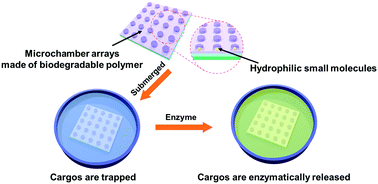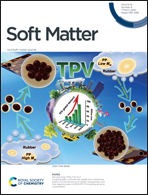Microchamber arrays made of biodegradable polymers for enzymatic release of small hydrophilic cargos†
Abstract
The encapsulation of small hydrophilic molecules and response to specific biological triggers in a controlled manner have become two of the significant challenges in biomedical research, in particular in the field of localized drug delivery and biosensing. This work reports the fabrication of free-standing microchamber array films made of biodegradable polymers for the encapsulation and enzymatically triggered release of small hydrophilic molecules. Polycaprolactone (PCL) microchamber arrays were demonstrated to fully biodegrade within 5 hours of exposure to lipase from Pseudomonas cepacia (lipase PS) at a concentration of 0.5 mg ml−1, with lower concentrations producing correspondingly longer degradation times. The gradual process of deterioration was real-time monitored utilising laser Fraunhofer diffraction patterns. Additionally, a small hydrophilic molecule, 5(6)-carboxyfluorescein (CF), was loaded into the PCL microchamber arrays in a dry state; however, the substantial permeability of the PCL film led to leakage of the dye molecules. Consequently, polylactic acid (PLA) was blended with PCL to reduce its permeability, enabling blended PCL–PLA (1 : 2 ratio correspondingly) microchamber arrays to trap the small hydrophilic molecule CF. PCL–PLA (1 : 2) microchamber arrays hold potential for controlled release under the catalysis of lipase within 26 hours. Additionally, it is calculated that approximately 11 pg of CF dye crystals was loaded into individual microchambers of 10 μm size, indicating that the microchamber array films could yield a highly efficient encapsulation.



 Please wait while we load your content...
Please wait while we load your content...